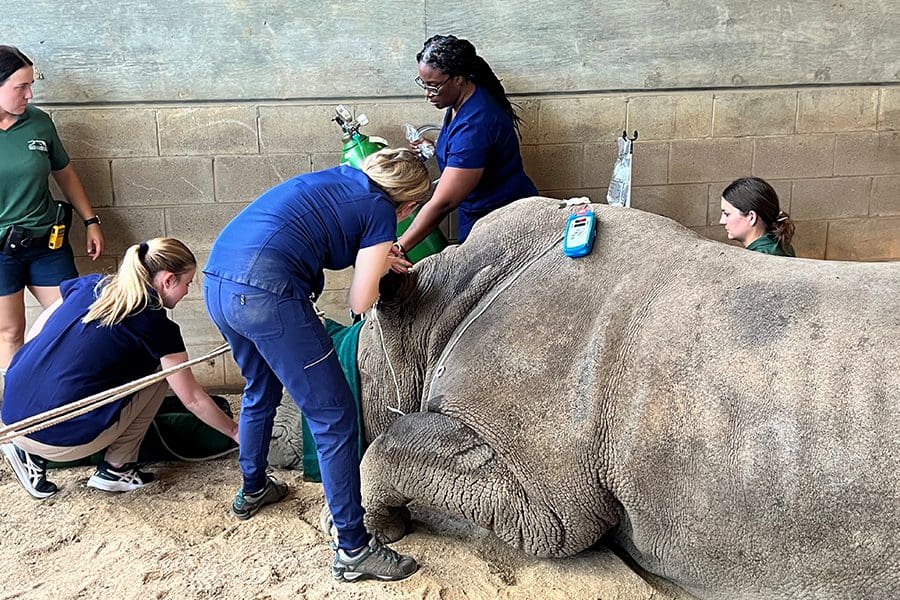

Kibibi is cared for by a team of animal care and veterinary staff during her AI procedure.
Editor’s note: This is the latest in a series of blogs on the process of using artificial insemination on our female Southern white rhinoceroses. You can read our initial post here and Part II here.
Since 2003, southern white rhinoceroses have called our Zoo home. After years of caring for rhinos with no successful conception, we turned to artificial insemination to help our two female southern white rhinos, Kibibi and Uzuri, reproduce and add to the population of this amazing – and critical – species.
We’re thrilled to share that Kibibi recently reached the goal of being artificially inseminated. While we can’t yet confirm that she’s pregnant, we are hopeful!
This moment has been years in the making, and it has required the time, patience, coordination and expertise of animal care and veterinary teams at our Zoo and with the nonprofit South-East Zoo Alliance for Reproduction and Conservation (SEZARC) and Omaha’s Henry Doorly Zoo and Aquarium. Part of the reason for this long process is our Zoo’s dedication to animal wellness, which entails ensuring our animal residents have meaningful choice and control in their lives with us. It was important for both our female rhinos to feel comfortable and prepared for the possibility of this moment – a process we go into more detail about below.
Why AI
We want to do our part in supporting the population of white rhinos and other threatened species so that they have long-term genetic diversity. After extensive research and discussions among staff, veterinarians and experts, we decided to explore using artificial insemination (AI) for Uzuri and Kibibi. This is an assisted reproductive technology used worldwide in both humans and animals to deposit stored semen directly into an individual’s uterus. This technique allows us to best match genetics to contribute to a genetically diverse population of white rhinos.
A few years ago, we began working with SEZARC, a not-for-profit group dedicated to increasing the populations of rare and endangered species through reproductive science. Researchers at Omaha’s Henry Doorly Zoo and Aquarium, SEZARC, Taronga Conservation Society, Australia and SeaWorld Entertainment, Inc. are the lead scientists for a study that our female rhinos are a part of. This study, which is funded by the Institute of Museum and Library Services, is focused on a protocol for artificial insemination that would benefit the sustainability of the white rhinoceros population.
Giving Our Rhinos Meaningful Choices
In the last blogpost we wrote about rhino AI, we let you know that we had been working with both Uzuri and Kibibi on undergoing testing, getting comfortable with their custom chute (a safe place for this process to take place in), increasing their time spent in that area and standing for voluntary ultrasounds. Based on training and testing, we were given the go-ahead to move forward with 22-year-old rhino Uzuri.
We let our rhinos decide whether they want to enter the chute or stand for an ultrasound – and for how long. For several months, Uzuri voluntarily went through this process with us, until one day, she decided that she didn’t want to anymore. While we were disheartened, we respected Uzuri’s choice as the entire process is voluntary and decided to give both her and 21-year-old Kibibi a break before we tried again.
Another Try
Based on their behavior in the months that followed, we felt comfortable starting again in late 2022. We made the decision to give Uzuri a longer break and focus on Kibibi this time around.
“Kibibi has always done very well with chute training,” said Chelsea Herman, a Curator of Animals. “Last time, Uzuri let us know when she no longer wanted to participate, and we carefully monitored Kibibi for any of those behaviors.”
Fortunately, Kibibi remained motivated throughout the entire process and voluntarily participated in all of her scheduled ultrasounds! In January, we started the process to trigger ovulation, or egg development and release, for Kibibi. “As her dominant follicle started to mature and near the ovulation phase, her ultrasounds increased in frequency until ovulation was documented,” said Zoo veterinarian Dr. Kyle Donnelly. At that point, Kibibi was ready for insemination.
The Big Day
On the actual day of insemination in mid-February 2023, SEZARC was onsite at the Zoo to perform the AI. Kibibi received ultrasounds every 2-3 hours until we identified ovulation. Once we were able to confirm, she was sedated by our veterinary team and artificially inseminated using a catheter.
Now, we wait! After about a month and a half, we would expect to see early stages of pregnancy. Our veterinary team will continue to perform ultrasounds and bloodwork to monitor. While there is no guarantee that this was successful, we are cautiously optimistic.
If Kibibi is in fact pregnant, we still wouldn’t see a baby rhino for quite some time! Rhinos typically give birth to one offspring after a 16-month gestation. Female rhinos can reproduce from the age of five up into their late 40s.
We will continue to keep you updated, so keep an eye out for news!
Brevard Zoo is an independent, not-for-profit organization that receives no recurring government funding for our operating costs. Your generous support enables us to continue to serve our community and continue our vital animal wellness, education and conservation programs.